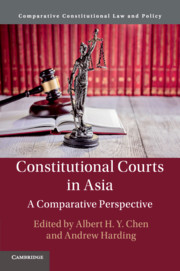44 results
Remarkable insights into modern bird origins from the Maastrichtian type area (north-east Belgium, south-east Netherlands)
-
- Journal:
- Netherlands Journal of Geosciences / Volume 103 / 2024
- Published online by Cambridge University Press:
- 13 May 2024, e15
-
- Article
-
- You have access
- Open access
- HTML
- Export citation
Astrobiological applications of μ-mapping X-ray fluorescence spectrometry
-
- Journal:
- International Journal of Astrobiology / Volume 23 / 2024
- Published online by Cambridge University Press:
- 04 March 2024, e8
-
- Article
-
- You have access
- Open access
- HTML
- Export citation
4 - Constitutions and Constitutionalism: China
- from II - Concepts and Definitions
-
-
- Book:
- Constitutionalism in Context
- Published online:
- 17 February 2022
- Print publication:
- 17 February 2022, pp 61-86
-
- Chapter
- Export citation
Increased risk of type 2 diabetes among the siblings of patients with schizophrenia
-
- Journal:
- CNS Spectrums / Volume 24 / Issue 4 / August 2019
- Published online by Cambridge University Press:
- 03 January 2019, pp. 453-459
-
- Article
- Export citation
8 - The Constitutional Orders of ‘One Country, Two Systems’
- from Part II - The View from Asia Pacific and the Middle East
-
-
- Book:
- The Invisible Constitution in Comparative Perspective
- Published online:
- 02 November 2018
- Print publication:
- 08 November 2018, pp 230-267
-
- Chapter
- Export citation
Preface
-
- Book:
- Constitutional Courts in Asia
- Published online:
- 17 September 2018
- Print publication:
- 20 September 2018, pp xvii-xviii
-
- Chapter
- Export citation
Figures
-
- Book:
- Constitutional Courts in Asia
- Published online:
- 17 September 2018
- Print publication:
- 20 September 2018, pp ix-ix
-
- Chapter
- Export citation
Index
-
- Book:
- Constitutional Courts in Asia
- Published online:
- 17 September 2018
- Print publication:
- 20 September 2018, pp 365-388
-
- Chapter
- Export citation
Tables
-
- Book:
- Constitutional Courts in Asia
- Published online:
- 17 September 2018
- Print publication:
- 20 September 2018, pp x-x
-
- Chapter
- Export citation
Copyright page
-
- Book:
- Constitutional Courts in Asia
- Published online:
- 17 September 2018
- Print publication:
- 20 September 2018, pp vi-vi
-
- Chapter
- Export citation
1 - Constitutional Courts in Asia
-
-
- Book:
- Constitutional Courts in Asia
- Published online:
- 17 September 2018
- Print publication:
- 20 September 2018, pp 1-31
-
- Chapter
- Export citation
Contents
-
- Book:
- Constitutional Courts in Asia
- Published online:
- 17 September 2018
- Print publication:
- 20 September 2018, pp vii-viii
-
- Chapter
- Export citation
Contributors
-
- Book:
- Constitutional Courts in Asia
- Published online:
- 17 September 2018
- Print publication:
- 20 September 2018, pp xi-xvi
-
- Chapter
- Export citation

Constitutional Courts in Asia
- A Comparative Perspective
-
- Published online:
- 17 September 2018
- Print publication:
- 20 September 2018
7 - Hong Kong’s Judiciary under ‘One Country, Two Systems’
-
-
- Book:
- Asia-Pacific Judiciaries
- Published online:
- 07 December 2017
- Print publication:
- 21 December 2017, pp 131-168
-
- Chapter
- Export citation
On the integration of product and process models in engineering design
-
- Journal:
- Design Science / Volume 3 / 2017
- Published online by Cambridge University Press:
- 21 March 2017, e3
-
- Article
-
- You have access
- Open access
- HTML
- Export citation
The Law and Politics of the Struggle for Universal Suffrage in Hong Kong, 2013–15
-
- Journal:
- Asian Journal of Law and Society / Volume 3 / Issue 1 / May 2016
- Published online by Cambridge University Press:
- 22 January 2016, pp. 189-207
-
- Article
-
- You have access
- HTML
- Export citation
A survey on text mining in social networks
-
- Journal:
- The Knowledge Engineering Review / Volume 30 / Issue 2 / March 2015
- Published online by Cambridge University Press:
- 25 March 2015, pp. 157-170
-
- Article
-
- You have access
- HTML
- Export citation
Diabetes and cognitive outcomes in a nationally representative sample: the National Health and Aging Trends Study
-
- Journal:
- International Psychogeriatrics / Volume 26 / Issue 10 / October 2014
- Published online by Cambridge University Press:
- 30 July 2014, pp. 1729-1735
-
- Article
- Export citation
Constitutionalism in Asia in the Early Twenty-First Century - Half title page
-
- Book:
- Constitutionalism in Asia in the Early Twenty-First Century
- Published online:
- 05 July 2014
- Print publication:
- 17 April 2014, pp i-i
-
- Chapter
- Export citation



